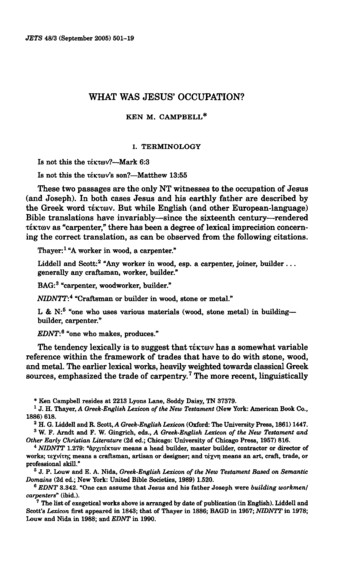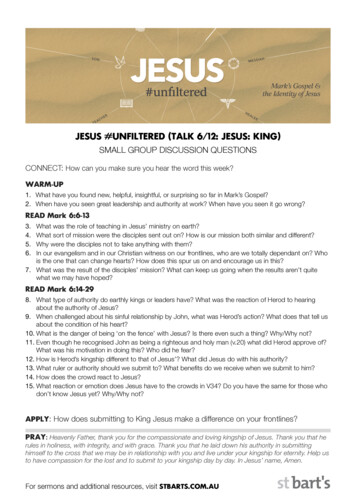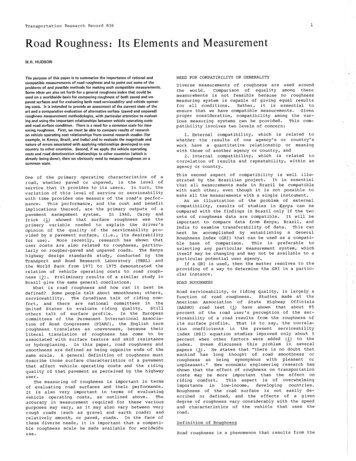
Transcription
JETS 48/3 (September 2005) 501!19WHAT WAS JESUS' OCCUPATION?KEN M. CAMPBELL*I. TERMINOLOGYIs not this the τέκτων?—Mark 6:3Is not this the τέκτων'β son?—Matthew 13:55These two passages are the only NT witnesses to the occupation of Jesus(and Joseph). In both cases Jesus and his earthly father are described bythe Greek word τέκτων. But while English (and other European!language)Bible translations have invariably—since the sixteenth century—renderedτέκτων as "carpenter," there has been a degree of lexical imprecision concerning the correct translation, as can be observed from the following citations.Thayer:1 "A worker in wood, a carpenter."Liddell and Scott:2 "Any worker in wood, esp. a carpenter, joiner, builder . .generally any craftsman, worker, builder.,,BAG:3 "carpenter, woodworker, builder."4NIDNTT: "Craftsman or builder in wood, stone or metal."L & N:5 "one who uses various materials (wood, stone metal) in building—builder, carpenter."EDNT:6 "one who makes, produces."The tendency lexically is to suggest that τέκτων has a somewhat variablereference within the framework of trades that have to do with stone, wood,and metal. The earlier lexical works, heavily weighted towards classical Greeksources, emphasized the trade of carpentry.7 The more recent, linguistically* Ken Campbell resides at 2213 Lyons Lane, Soddy Daisy, TN 37379.1J. H. Thayer, A Greek!English Lexicon of the New Testament (New York: American Book Co.,1886) 618.2H. G. Liddell and R. Scott, A Greek!English Lexicon (Oxford: The University Press, 1861) 1447.3W. F. Arndt and F. W. Gingrich, eds., A Greek!English Lexicon of the New Testament andOther Early Christian Literature (2d ed.; Chicago: University of Chicago Press, 1957) 816.4NIDNTT 1.279: "αρχιτέκτων means a head builder, master builder, contractor or director ofworks; τεχνίτης means a craftsman, artisan or designer; and τέχνη means an art, craft, trade, orprofessional skill."5J. P. Louw and E. A. Nida, Greek!English Lexicon of the New Testament Based on SemanticDomains (2d ed.; New York: United Bible Societies, 1989) 1.520.6EDNT 3.342. "One can assume that Jesus and his father Joseph were building workmen/carpenters" (ibid.).7The list of exegetical works above is arranged by date of publication (in English). Liddell andScott's Lexicon first appeared in 1843; that of Thayer in 1886; BAGD in 1957; NIDNTT in 1978;Louw and Nida in 1988; and EDNT in 1990.
502JOURNAL OF THE EVANGELICAL THEOLOGICAL SOCIETYimproved lexical publications focus mainly on "craftsman" or "builder" as thepreferred translation. For example, J. I. Packer writes in NIDNTT concerning Matt 13:55 and Mark 6:3 that "τέκτων could equally mean 'mason' or'smith' (as indeed some of the fathers took it); or it could mean that Josephand Jesus were builders, so that carpentry and masonry would have been8among their skills." The current editions of BAGD and Liddell, Scott, andJones give improved renderings, de!emphasising "carpenter," e.g. "one whoconstructs, builder, carpenter."In an earlier study of the term τέκτων, C. C. McCown concluded that"classical and Hellenistic literature as well as the papyri offer abundant evidence to prove that τέκτων was almost universally reserved for the workerin wood and was only very rarely applied to artisans who used other materials."9 But trawling through the usages of Homer, Plato, and other classical writers of ancient eras does little to enable the modern reader tounderstand the sense of the term as it was employed in a specific historicaland cultural context centuries later. The methodology employed here will beto first study the instances of τέκτων in secular Greek in the century beforeand after the NT occurrences, then to consider the writings of the first!century authors Josephus and Philo. Attention will also be given to the OTas the formative literature on the thinking of Jesus and the disciples, andthen to other Second Temple Jewish writings. Finally, we will consider someearly non!canonical Christian literature. Thus we will arrive at the wordsense of the immediate linguistic context to the statements of the Gospelauthors cited above.First, we explore the range of the term in secular Greek in the first centuries BC and AD. In all but two cases the Loeb translation is offered afterthe word, which will serve to underline the variability and subjectivity ofthe choices made by the respective translators.1. Greek writers.a. Apollodorus.10We should, therefore, choose the calling appropriate to ourselves . . . and notprove that Hesiod spoke inexactly when he said "Potter is angry with potter,τέκτονι τέκτων (joiner with joiner)" (De tranquilitate animi 473.Α.11).8NIDNTT 1.279.C. C. McCown, "Ό Τέκτων," in Studies in Early Christianity (ed. S. J. Case; New York: TheCentury Co., 1928) 176. McCown did recognize that "[t]he Hebrew word Harash appears never tohave become specialized and was always used for 'artisan' in general, the context or the denningmodifier being necessary to determine its meaning" (p. 174). A similar view is argued by Paul H.Furfey in "Christ as τέκτων," CBQ 17 (1955) 324!55. Furfey goes farther in arguing that "it isquite likely that he devoted the greater part of his time to other types of woodworking, the fabrication of furniture and other wooden objects" (p. 205). Like McCown, Furfey bases his conclusionson the classical Greek sources, other contemporary languages, and some of the Church fathers.Notably absent from both treatments are the Jewish sources and the Jewish context.10Appolodorus, Bibliotheca.9
503WHAT WAS JESUS' OCCUPATION?Α τέκτων (carpenter) likewise in making a tiller would be more pleased if heknew that it would steer the flagship of Themistocles fighting in defense ofHellas (Maxime cum principibus philosopho esse deserendum 779.A.6).An αρχιτέκτων chooses subordinates and χειροτέχνας (handicraftsmen) who willnot spoil his work but will co!operate to perfect it (Praecepta gerendae reipub!licae 807.C.3).Daedalus, an αρχιτέκτων . . . constructed a wooden cow on wheels (3.10.1).Daedalus . . . was an excellent αρχιτέκτων and the first inventor of images(3.15.8).b. DioChrysostom.nIf he is a dyer or a cobbler or a τέκτων (craftsman), it is unbecoming to makethese occupations a reproach (34.23.11).Both potter at potter doth rage, and τέκτονι τέκτων (joiner at joiner) (77/78.1.8).The physician . . . has a profession not inferior to that of the τεκτόνων (joiners)(77/78.87.2).They would recognize that it is not right nor for their own good for a τέκτων tobe jealous or angry because of his craft (τέχνην), whether it was blacksmithagainst blacksmith or τέκτονι τέκτων (joiner against joiner) (77/78.13.7).Someone affected by riches and fame "goes about as neither farmer nor tradernor soldier nor general, nor as shoemaker or τέκτων (builder) or physician ororator" (80.1.5).c. DiodorusSiculus.12Αρχιτέκτων is used by this writer twice in a"schemer" (16.61.2.1; 29.25.1.10).figurativesense, i.e.d. LexiconHomericum.13This work contains a vocabulary list that mentions τέκτων.e.Epictetus.14The τέκτων (carpenter/builder) becomes a τέκτων first by learning something,the helmsman becomes a helmsman by first learning something (2.14.10.1).When I see a τέκτων (craftsman) who has material lying ready to hand, I lookfor the finished product. Here also, then, is the τέκτων, and here is the material; what do we yet lack? (2.19.31.3).The τέκτων (builder) does not come forward and say, "Listen to me deliver adiscourse about the art of building" (τεκτονικών); but he takes a contract for ahouse, builds it, and thereby proves that he possesses the art (3.21.4.1).1112Dio Chrysostum, Orationes.Diodorus Siculus, Bibliotheca Histórica.Lexicon Homericum 150, 31.14Epictetus, Dissertationes ab Arriano Digestae.13
504JOURNAL OF THE EVANGELICAL THEOLOGICAL SOCIETYYou will find the same thing in the arts. If you want to be a τέκτων (carpenter),you will have such and such exercises; if a blacksmith, such and such other(3.23.3.1).The citharoede is to act as a citharoede, the τέκτων (craftsman) as a τέκτων,the philosopher as a philosopher, the rhetor as a rhetor (3.23.5.3).Now can anyone do good to others unless he has received good himself? Nomore than the ηοη!τέκτων (builder/carpenter) can help others in building/carpentry (τεκτονικήν), or the non!cobbler in cobbling (3.23.8.3)."This man is a τέκτων" (builder/carpenter). Why? "He uses an adze" (4.8.4.2).When someone sees a fellow hewing clumsily with an axe, he does not say"What's the use of τεκτονικής? See the bad work τέκτονες (carpenters) do," butquite the contrary, he says, 'This fellow is no τέκτων, for he hews clumsily withthe axe" (4.8.7.4).Does the inattentive τέκτων (craftsman) do his work more accurately? The inattentive helmsman more safely? (4.12.5.2).f.Plutarch.And so an αρχιτέκτων (smith) would regard his task as the welding of iron orthe tempering of an axe rather than any one of the things that have to be donefor this purpose, such as blowing up the fire, or getting ready a flux (Septemsapientium convivium 156.B.11).Poemander. . . fortified Poemandria. Plycritus the αρχιτέκτων, however, whowas present, spoke slightingly of the fortifications (Aetia Romana et Graeca299.C.10).Among the other τεχνίταις (artists) at his court was Stasicrates the αρχιτέκτων(master!sculptor), not seeking to make something flowery or pleasant or lifeliketo look upon, but employing a magnificence in workmanship and design worthyof a king's munificence (De Alexandri magni fortuna aut virtute 355.C.3).To hear Euripides quoted to boot, "Α τέκτων (joiner) thou yet didst a task essaythat was no ξυλουργικά" (carpentry) (Praecepta gerendae Republicae 812.E.9).Homer was not only admirable in other ways, but also a very wise αρχιτέκτων,and ordered the plan of the city to be drawn in conformity with this site (Alexander 26.4.6).g. Rufus EphesusMed.15In the same way it certainly does not begin to teach the other skills, alsothe brass!worker, the leather!worker, the τέκτων . . . (De corporis humaniappellationibus).Leaving aside the two figurative occurrences (schemer), it is evident thatto the various translators of the Greek texts cited above the precise mean!15Rufus Ephesus Med., "De corporis humani appelationibus," Oeuvres de Rufus d'Ephèse(ed. C. Daremberg and C. E. Ruelle; Paris: Imprimerie Nationale, 1879 [reprint: Amsterdam:Hakkert, 1963]) 3.
WHAT WAS JESUS' OCCUPATION?505ing of τέκτων is sometimes less than totally clear from the context. In someinstances, it seemed best to render it as (a) builder; (b) carpenter; (c) smith;(d) sculptor; (e) joiner. Four times τέκτων is contrasted with (a) smith; (b)potter; (c) cobbler. Five times the term αρχιτέκτων is employed, meaningmaster builder or architect, and even master!sculptor. In the case of the othereight instances, it was considered wisest to render τέκτων in such generalterms as builder, craftsman, or artisan.2. Philo. Now we turn to the Jewish philosopher Philo. Though Jewish,Philo of Alexandria inhabited a mental world of Hellenistic philosophy andcultural values, so it is not surprising to find him employing the word τέκτωνin ways similar to the secular Greek writers. He does so three times."The τέκτονα ("carpenter) and the painter and the husbandman and themusician and those who practice other arts (τέχνας) . . . the τεκτονικός (carpenter) takes and carves a piece of timber . . . we speak not only of carpenters, but of practicing carpentry (τέκτονι το τεκτονεΐν)" (Sobr. 35.36)."Some of the arts . . . are practical, but not theoretical, as the arts of theτεκτονικει, χαλκευτικει (carpenter and coppersmith)" (Leg. 57).These instances could be rendered as craftsman, but carpenter wouldsuit the contexts better.3. Josephus. Turning now to Flavius Josephus, he employs τέκτων fourtimes in the War, and seven times in the Antiquities. There is an interestingdifference between the two works in regard to the usage of this word. First,the Antiquities.Moses, after recompensing with fitting bounties the τέκτονας (craftsmen) whohad executed works so excellent, sacrificed . . . (3.204).They (rulers) will make of them τεχνίτας (craftsmen), makers of armour, ofchariots and of instruments . . (6.40).Gifts of cedar wood and skilled men as τέκτονας και οικοδόµους (carpenters andbuilders) to construct a palace in Jerusalem (7.66).You also have many tens of thousands of µυριάδας καΐ τεκτόνων (stone cuttersand carpenters) (7.340).He had already secured many talents of gold and more of silver, and wood anda host of τεκτόνων πλήθος και λατόµων (carpenters and stone cutters) as well asemeralds and precious stones (7.377).They also began the building of the temple, giving large sums of money to theλατόµοις και τέκτοσι (stone cutters and carpenters) (11.78). . . trained some as οικοδόµους (builders), others as τέκτονας (carpenters)(15.390).All of these occurrences of the word have to do with the tabernacle or thetemple or the palace, and plainly Josephus in his reading of the Hebrew textunderstands τέκτων in these contexts to refer usually to workers in wood. Inthe War, however, where Josephus writes concerning events contemporary
506JOURNAL OF THE EVANGELICAL THEOLOGICAL SOCIETYto himself, the referent is different. Describing the fortification of the campsof the Roman armies prior to battle, he portrays the leveling of the groundand the measurement of a square:For this purpose the army is accompanied by τεκτόνων πλήθος (a multitude ofworkmen) and of tools for building (3.78).Josephus . summoned τέκτονας (masons) and directed them to increase theheight of the wall (3.171).Under this screen the τεκτόνων (builders) raised the wall to a height of twentycubits (3.173).The works being completed, the τέκτονες (engineers) measured the distance tothe wall with lead and line (5.275).All of these references are to the work of builders. Wood is not involved,16but earth and stones. So in his commentary on the biblical story, Josephusemploys τέκτων to portray primarily the craft of carpentry, but in his contemporary references, about which he had first!hand knowledge, he understands the term to apply to the work of building or construction.4. Qumran. Inhabiting a geographical and cultural world more strictlyJewish than that of Josephus, the Essenes lived (according to Josephus) inmany places in Judea, but the prime record of their habitation lies twentymiles east of Jerusalem on the shores of the Dead Sea. The writings of theEssenes contain few references to the Hebrew equivalent of the term τέκτων, i.e. häräs, in the material that is legible.17 Only five clear instances ofhäräs are employed, with the usual OT meaning of "craftsman." They arefound in the War Scroll in contexts that deal with the material preparationsfor the coming conflict between the sons of light and the sons of darkness. . and precious stones, many colored ornaments, the work of a skillful häräs(craftsman) (Q491 5:6, 9, 10, 11).This phrase is repeated four times; each of the instances concerns thefashioning of swords, spears, and shields. . and the häräsim (smiths), and the smelters, and those enlisted to be . . . fortheir divisions" (4Q491 1-3, 7).In sum, the Hebrew word häräs was rarely employed by the Essenes andrefers to the craft of the smith, not the carpenter.One thing that Philo, Josephus, the Essenes, and the Gospel writers hadin common—and which set them apart from the secular Greek writers exam-16Except perhaps in 3.173: the term δρύφακτον (fence, railing) may refer to wood.There are two references to the use of the word to mean "sorcery" (4Q201 3:15; 4Q202 2:19);afour instances where the sense is "silence" or "dumb" (11Q19 T 52:13; 53:18; CD 9:6; Maslh Sir3:25; lQ28a 2:6); and one of the verb meaning "to plow" (11Q19 53:13). There are also a few instances of the word in which the context is indecipherable.17
WHAT WAS JESUS' OCCUPATION?507ined above—was their devotion to and their knowledge of the Scriptures ofthe OT. It is necessary, therefore, to review the Hebrew term that theseJewish writers (who thought in Aramaic/Hebrew first) translated as τέκτων.That term is häräs.5. The Old Testament. In the Hebrew Bible the verb häräs occurs 26times and means "to cut into, inscribe, to fabricate, out of metal. . . wood,stone, with an ace. of the material."18 Another lexicon says, "to engrave,plough, devise. The basic idea is cutting into some material, e.g. engravingmetal or ploughing soil."19 The generality of application is due to the factthat similar tools were employed to work different materials, most of whichwere designed to cut or carve something.The noun häräs occurs 35 times and means "craftsman; on stone, onwood; metal worker (smith), armourer; workers of wood and stone; of woodand metal.,,2 Again, another lexicon gives this rendering: "Engraver, artificer(a) in metal (b) in wood (c) in stone (d) general."21 NIDOTTE gives "craftsman, artisan," while Cline has "artisan . . . worker in stone . . . in wood . . .in metal."22These conclusions are based on the following passages.First, uncertainties arise in several passages where häräs is set alongside or distinguished from a related term. For example, we find häräs distinguished from (a) builders, masons, stone cutters in 2 Kgs 12:11, 12; 22:6;(b) smiths in 2 Kgs 24:14, 16; Isa 40:19; 41:7; Jer 24:1; 29:2; 2 Chr 34:11;(c) masons in 2 Sam 5:11; 1 Chr 14:1; 22:15; 2 Chr 24:12; Ezra 3:7; (d)woodsman in 1 Chr 22:14 (häräs eben wa'ès)', (e) weavers and designers inExod 38:23. While this fluidity can be confusing to the reader, the biblicalauthors evidently intend to distinguish between various kinds of craftsmenand assume that the context sufficiently defines the particular trade or skillin that specific situation. In temple contexts it appears that workers inwood were most frequently intended.Second, there are texts in which the meaning is clearly smiths or metalworkers, often in the context of fashioning idols: Deut 27:15; 1 Sam 13:19;Isa 40:19; 44:11-12; 45:16; 54:16; Jer 10:9; Hos 8:6; 13:2; 1 Chr 29:5. Thenin the following contexts, which are concerned with the tabernacle and thepriestly garments, häräs means engravers of precious stones: Exod 28:11;18E. Kautzsch, ed., Gesenius' Hebrew Grammar (trans. A. E. Cowley; 2d ed.; Oxford: OxfordUniversity Press, 1910) 309.19 TWOT 1.327. See also TDOT 5.220-23.20KB 1.358.21BDB 360. See TWOT 1.328: "Engraver, carpenter, smith, mason. . . The Ugaritic namemeans craftsman." Also Gesenius: "(1) An engraver of stones (2) an artificer, of iron, brass, stone,wood (a smith, mason or carpenter)" (p. 309). On the Ugaritic, see S. E. Lowenstamm: "The Hebrew Root häräsh in Light of the Ugaritic Texts," JJS 10 (1959) 63-65.22NIDOTTE 2.298. See also David J. A. Clines, ed., Dictionary of Classical Hebrew (Sheffield:Sheffield Academic Press, 1993) 3.324.
508JOURNAL OF THE EVANGELICAL THEOLOGICAL SOCIETY35:35. In one passage only should the translation undoubtedly read carpenters or workers in wood: Jer 10:3. At least one example requires the generalsense of craftsman: 1 Chr 4:14.In the above group of passages, where the intended meaning is clear fromthe contexts, it is evident that the usual referent is not to carpenters, butto those who cut or engrave in stone or metal. Most of the passages nothaving to do with idolatry appear in contexts that portray the building ofthe tabernacle or the temple, as we might expect. The reader, in short, mustdeduce from the literary context which trade is referred to by the generalterm häräs unless a defining modifier is given, which sometimes is the case.For example, the phrase häräs ëtzim ("carpenter") is employed in 2 Sam5:11; 2 Kgs 12:11,12; 1 Chr 14:1; 22:15; Isa 44:13. The phrase häräs eben("mason") appears also in Exod 28:11; 2 Sam 5:11; 1 Chr 22:15. We alsoencounter in the OT häräs barzel ("smith"), häräs nehösheth ("coppersmith"), häräs qîr ("builders of walls"), häräs sîrîm ("idol-maker"). Translation would be simpler if such modifiers were employed in all OT instancesof the word häräs, but unfortunately the biblical writers were often contentto use the general term. It is, however, notable that the term for "carpenter"(naggar), which occurs in the Mishnah and Talmud, is not found in the OT.To summarize: the ancient Hebrews were apparently content to employthe general term häräs ("craftsman," "builder," "artisan") for a variety ofskills or trades which involved cutting or carving, and to render specificityat times by means of a modifier or a more or less clear contextual reference.23 This implies that the Israelite häräs did not limit himself to working with only one material. He could move from stone to metal to wood asthe need or opportunity arose (Neh 3:8, 31), and while he could probablyspecialize in one material if that was advantageous, he did not normally restrict himself in this way, as many modern tradesmen do.24Indeed, this is more or less the job description of the first master craftsman/builder, Bezalel:The Lord has called by name Bezalel. and he hasfilledhim with the Spirit ofGod, in wisdom, in understanding and in knowledge, and in all craftsmanship;to make designs for working in gold and in silver and in bronze, and in the cutting of stones for settings and in the carving of wood . . . (Exod 35:30-33).6. The Septuagint. The most common translation of häräs in the LXX isτέκτων (22 times). 25 In addition, τεχνίτης is employed 6 times, τέχνη once,αρχιτέκτων twice, and χαλκεύς once. Basically, it functions in the samemanner as the Hebrew term, sometimes being used in the general sense of"craftsman" (MT 24, LXX 19) and sometimes with a defining modifier, e.g.23There are few references to tools in the OT (but see 1 Kgs 6:7: "Hammers, chisel, or irontool"; and Isa 44:13: "rule, chalk, plane, compass").24Although in modern commercial construction, workers who fit panels of various materialssuch as plastic, even concrete, are still referred to at times as "carpenters," because of the transferability of the skills required.25Other renderings are αροτριον ("plow") 12 times; θερίζειν ("reap") twice; λιτουργός twice.
WHAT WAS JESUS' OCCUPATION?509ξύλων, λίθων, χαλκούς, συγκλείοντα, χρυσοχόος, σίδηρον, δεσµώτας, λατόµοις(ΜΤ 9, LXX 12). In one instance, häräs is rendered by a descriptive phrase(Exod 35:35); in another instance, the LXX is a mistranslation ("deafIsa 44:11), and in three cases the LXX translators added a specifier whichis justified by the context (1 Sam 13:19; Isa 54:16; 1 Chr 14:1). As with theHebrew häräs, the LXX occurrences of τέκτων and τεχνίτης appear in twomain contexts: the tabernacle/temple/palace narratives (nine without aspecifier, seven with), and in connection with idol manufacture (thirteenwithout, five with a specifier). There are two other occurrences which appearin relation to (a) weaponry: τέκτων σίδηρου renders häräs; (b) genealogy: inIsa 54:16 häräs is rendered as χαλκεύς (smith). Twice the Greek wordοικοδόµος is used to translate häräs (1 Chr 14:1; 22:15).It would appear that the LXX translators were fairly consistent, but notrigidly so, in translating the MT. In fact, in the OT the only contexts in whicha modifier is added to the general terms häräs/τέκτων, apart from two prophetic texts, are those that describe the monumental construction projectsof the tabernacle, temple, and palace. Only there was there need for specialization in construction. Otherwise, craftsmen employed their cutting/carvingskills on any relevant material: stone, wood, metals. It is the general termτέκτων that the Gospel writers employed—without the modifier—to define theoccupation of Joseph and Jesus.7. Jewish apocrypha. In this variegated body of literature that was incirculation between 200 BC and AD 100, there are only six instances of τέκτων (apart from three occurrences which are figurative in meaning: devise,scheme).26 All appear in contexts that deal with either the making of idolsor the construction of the temple.They gave money to the masons and carpenters (1 Esdr 5:54).to the masons and carpenters (τοις λατόµοις και τοις τέκτοσιν) (2 Esdr 3:7).Concerning idols: their tongue is polished by the τέκτων, and they themselvesare overlaid with gold and silver (Ep Jer 8).they are fashioned by carpenters and goldsmiths: they can be nothing else thanthe workmen will have them to be (Ep Jer 45).In the famous section titled "The superiority of the scribe over the laborerand artisan,, (Sir 38:24!30), the author's point is not really to denigrate laboras such (as is the case in the Egyptian precursor "The Satire on the Trades")27but to portray the work of the scribe as vastly superior. The writer mentionsengravers, metalworkers, and potters. In verse 27 he states:So it is with every artisan and master artisan (τέκτων και αρχιτέκτων).This is the NRSV translation. It is interesting to note the variety of othertranslations of this phrase: "engravers and designers" (NAB); "carpenters2627Sir 11:33; 27:22; Bar 3:18.See P. W. Skehan and A. A. Delella, The Wisdom of Ben Sira (New York: Doubleday, 1987).
510JOURNAL OF THE EVANGELICAL THEOLOGICAL SOCIETYand workmasters" (KJV); "craftsmen and workmasters" (Douay); "workmenand craftsmen" (NJB). The uncertainty of the translators well illustrates thefluidity and variability of the original Greek (and Hebrew).8. Pseudepigrapha.There is one important instance in the Pseudepig!rapha. 2 8 In Sib. Or. 5.543 we read,Nor did wise workmen (τέκτων) make a stone by them.This is not carpentry, but masonry.9. Mishnah and Midrash.There is little consistency in the rabbinicsources in the first centuries after Christ. Since the talmudic material is solate, this review is restricted to the Mishnah and Midrash.a. The Midrash.29Twice bäna is employed:A builder requires six things (to build a house): water, earth, timber, stones,canes, and iron (Gen. R. 1:8).In human affairs, an earthly monarch builds a palace and roofs it over withstones, timber, and earth (Gen. R. 4:1)."Architect" is employed once:This may be compared to a master builder who built (architektös shèbânâ) acountry with secret chambers, canals and caves (Gen. R. 24:1).Twice the term naggär renders "carpenter":R Hoshaya said: Anyone who has knowledge and lacks the fear of sin, reallyhas nothing, just as a carpenter who has no tools with him is not a real carpenter (Exod. R. 40:1).Finally, we find that a term scarcely employed in the OT now is used to describe the craftsman:No-one loves his fellow-craftsman . . . the Holy One, blessed be He, also lovesHis fellow-craftsmen (i.e. the righteous) (Gen. R. 27:2).b. The Mishnah.four times.In the Mishnah, the same term 30 — y umän—appearsQid. 4:14: "a man should not teach his son a craft that is practiced amongwomen. R Meir says: a man should always teach his son a cleanly craft.B. Qam. 9:3: If he gave aught to craftsmen (Wûmanîn) to be mended, and theyspoiled it, they must make restitution. If he gave a carpenter (lehäräs) a box,chest, or cupboard to be mended, and he spoilt it, he must make restitution. Ifa builder (wëhabbannâ'î) undertook to pull down a wall. . . etc.28Another instance is found in Pseudo-Euripides from a much later date: "What sort of housefashiond by craftsmen (τεκτόνων) would contain the divine form in the folds of its walls?"29Quotations are from H. Freeman, ed., Midrash Rabba (10 vols.; London: The SoncinoPress, 1983).30 yOmmân does occur once in the OT: Song 7:2.
WHAT WAS JESUS' OCCUPATION?511Arak. 6:3: if he was a craftsman (yumän) they must leave him two of any kindof the tools of his craft. If he was a carpenter (häräs) they must leave him twoaxes and two saws.Häräs is the favorite word for carpenter. In Kel. 29:3 it is contrasted withbuilder:The cord . . . of a carpenter's (häräsin) plummet, up to eighteen; that of abuilder's (binyan) plummet, up tofiftycubits.Similarly, in Kel. 14:3:A builder's (banai) crowbar and a carpenter's (häräs) pick are susceptible touncleanness . . . a blacksmith's (nappâhîn) jack is susceptible . . .In summary, while the most popular word for carpenter is now häräs, &new term is also used: naggar. The general term "craftsman" is most frequently rendered by another word: yumän. These developments in usagethat took place in the two centuries after the fall of the temple continued inthe Talmudic period, but that is beyond the scope of this enquiry.3110. New Testament apocrypha. Few NT apocryphal books were writtenbefore the end of the second century. One that was important in the promotion of mariolatry in the early church is the Protevangelium of James. Thisfirst infancy narrative of Jesus is a glorification of Mary before and after thebirth of Jesus and of her alleged perpetual virginity.32 There are two passagesgermane to our study in this short work. In the first, Joseph speaks to Maryas follows:Now I leave you in my house and go away to build my buildings (οικοδοµείσαιτας οικοδόµας) (9:3).The second also concerns Joseph:when she was in her sixth month, behold, Joseph came from his building (αποτων οικοδόµων αύτοϋ) (13:1).In some of the later (usually Gnostic) apocryphal writings, Joseph and Jesusare portrayed as carpenters who carved wooden ornaments. For example,the Infancy Story of Thomas, one of the earliest of the Gnostic works, probably composed only slightly after the Protevangelium of James, states: "Hisfather was a carpenter, and made at that time plows and yokes."33 To the31Jastrow defines häräs as "artist, artisan, carpenter" (Marcus Jastrow, A Dictionary of theTargumim, The Talmud Babli and Yerushalmi, and the Midrashic Literature [New York: Pardes,1950] 1.507); auman as "skilled artist, artisan, professional cook, architect, etc."; naggar as "carpenter, turner, in gen., artisan." The Syriac amno is translated as "a craft, trade, or profession"and najjar as "a workman, esp., a carpenter" (J. Payne Smith, A Compendious Syriac Dictionary[Eugene, OR: Wipf and Stock, 1999] 20, 328). The Arabic versions take
Epictetus.14 The τέκτων (carpenter/builder) becomes a τέκτων first by learning something, the helmsman becomes a helmsman by first learning something (2.14.10.1). When I see a τέκτων (craftsman) who has material lying ready to hand, I look for the finished pro










